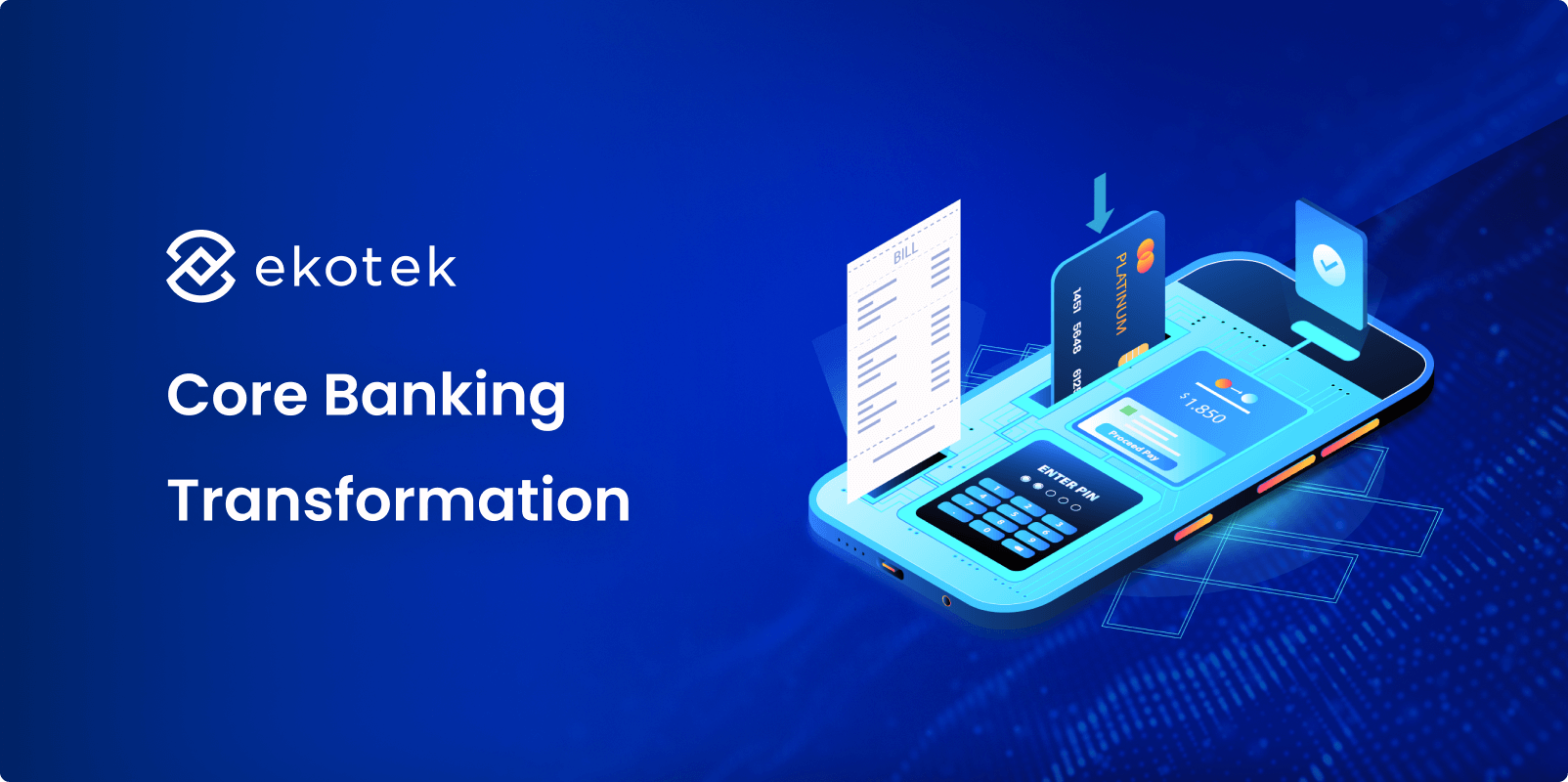
- 1
- 2
- 3
- 4
- 5
- 6
- 7
- 8
- 9
- 10
Introduction
The banking industry is at a critical crossroads. With digital disruption accelerating across all sectors, traditional banks are under mounting pressure to modernize their legacy systems, enhance customer experiences, and keep pace with agile fintech competitors. At the heart of this digital shift lies core banking transformation, a strategic imperative rather than a mere technology upgrade.
According to a 2024 McKinsey report, over 70% of global banks have identified core banking transformation as a top priority for the next three years. Yet, many remain unsure where to start or how to navigate the complexities involved.
In this blog, we’ll explore core banking transformation critical components, explain why it’s essential today and outline a step-by-step transformation strategy.
What is core banking transformation?
Core banking transformation refers to the end-to-end modernization of a bank’s central processing system, the core engine that manages customer accounts, transactions, loans, payments, and compliance. It’s not just a technical upgrade, but a strategic shift aimed at driving agility, scalability, and future-ready innovation.
Unlike a simple patch or software update, true transformation involves replacing outdated, monolithic systems with modern, cloud-native, and modular platforms. This shift allows banks to launch products faster, reduce operational costs, enhance customer experience, and seamlessly integrate technologies like AI, real-time analytics, and blockchain.
Think of it as replacing the engine of an airplane mid-flight, complex, but essential to compete and thrive in today’s dynamic financial landscape.
💡 Explore more in our Banking Digital Transformation Guide
Key components of core banking transformation
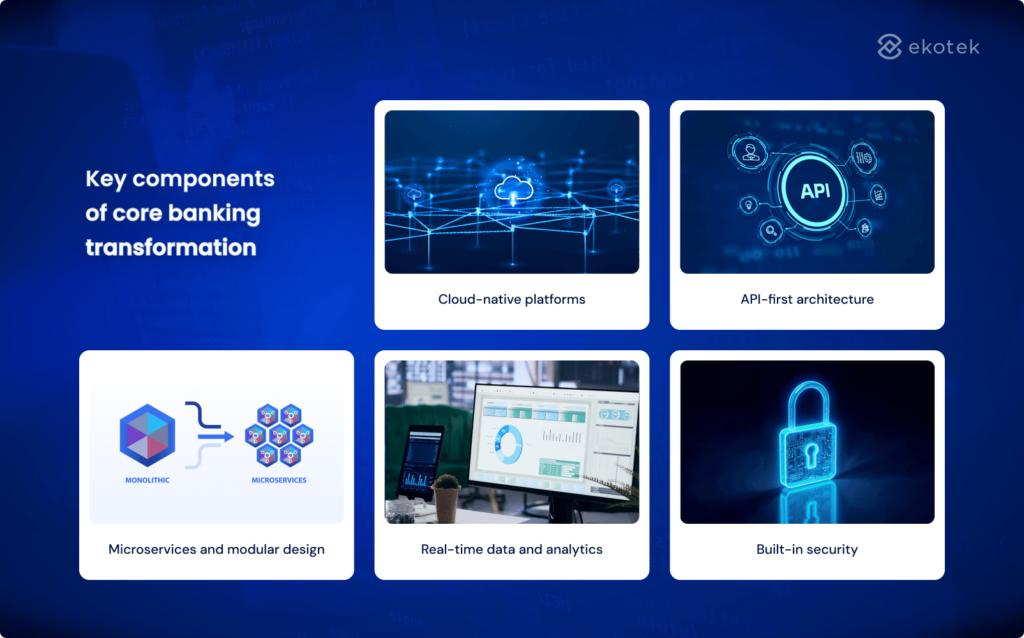
Cloud-native platforms
Banks are moving away from legacy on-premise systems to cloud-native platforms that offer real-time scalability, resilience, and lower infrastructure costs. This shift enables continuous deployment, high availability, and elastic capacity, crucial in today’s 24/7 banking environment.
API-first architecture
Modern core systems are built with APIs at the center, allowing seamless integration with fintech partners, third-party apps, and digital ecosystems. This flexibility is essential for open banking and future-proof innovation.
Microservices and modular design
Instead of monolithic systems, microservices architecture breaks core functionality into independent modules, such as payments, lending, and account management. This enables faster feature rollouts, targeted updates, and reduced risk of system-wide outages.
Real-time data and analytics
Next-gen core platforms support real-time transaction processing and analytics. Banks can monitor risk, detect fraud, and personalize offerings instantly, resulting in improved decision-making and customer experience.
Built-in security and compliance
Security and regulatory compliance are no longer add-ons, they’re baked into the architecture. From real-time auditing to advanced encryption, modern core systems help banks meet evolving regulatory demands and safeguard customer trust.
Why core banking transformation is critical today
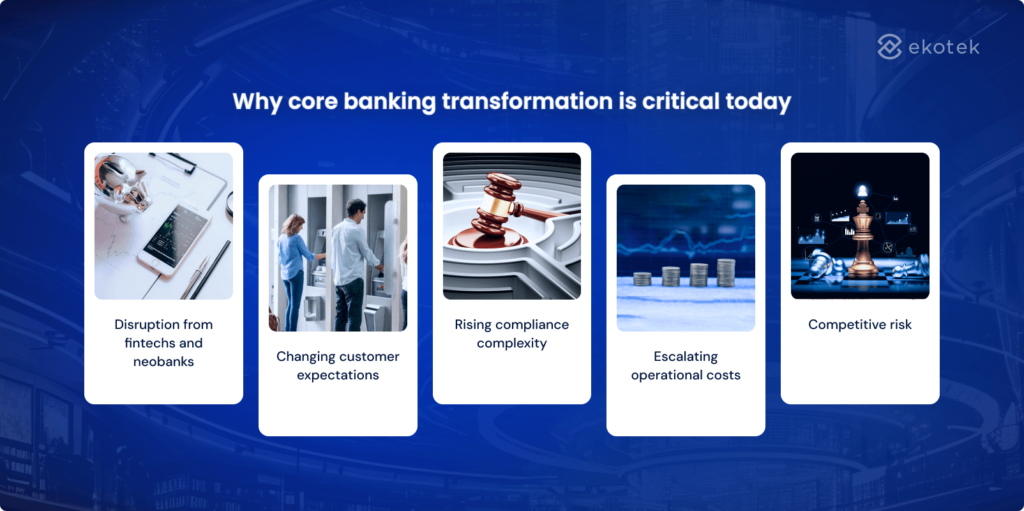
Disruption from fintechs and neobanks
Digital-native challengers like neobanks and fintech startups are redefining the customer experience with fast, mobile-first, and intuitive banking services. Traditional banks, constrained by legacy systems, struggle to match their speed, agility, and innovation.
Changing customer expectations
Modern banking customers expect real-time access, personalized financial products, and seamless digital experiences, across devices and channels. Legacy core systems can’t support the level of responsiveness or customization needed to meet these expectations.
Rising compliance complexity
From open banking mandates to data privacy laws (e.g., GDPR, PSD2), the regulatory landscape is becoming more dynamic and demanding. Banks need modern core systems that can adapt quickly and provide built-in compliance and audit capabilities.
Escalating operational costs
Maintaining and patching outdated infrastructure consumes a large portion of IT budgets. These systems are costly to run, slow to evolve, and prone to outages, making transformation not just strategic, but financially necessary.
Competitive risk of standing still
Failing to modernize puts traditional banks at a long-term disadvantage. Without core banking transformation, they risk losing market share, customer trust, and the ability to innovate at scale.
Strategic benefits of core banking transformation
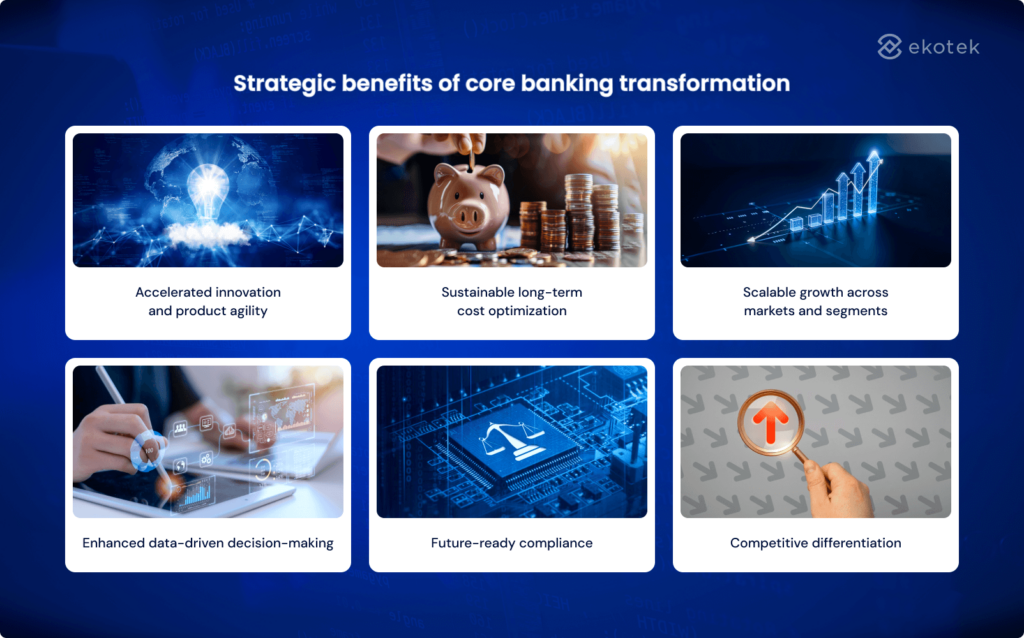
Accelerated innovation and product agility
Modern core systems are designed to support rapid product development, enabling banks to quickly respond to changing market needs. With flexible, modular architecture, financial institutions can test, iterate, and launch new services without disrupting core operations. This agility positions banks to compete more effectively with fintechs and adapt faster to customer trends.
Sustainable long-term cost optimization
While core transformation requires upfront investment, the long-term financial benefits are significant. Cloud-native systems reduce the need for physical infrastructure and minimize manual interventions through automation. Over time, banks can achieve lower total cost of ownership, greater operational efficiency, and increased IT budget flexibility for innovation.
Scalable growth across markets and segments
Legacy systems often limit a bank’s ability to expand efficiently. A modern core allows for scalable operations across multiple geographies, customer segments, and business units without reengineering the entire system. This makes it easier to launch new brands, digital subsidiaries, or region-specific services.
Enhanced data-driven decision-making
With real-time data processing and integrated analytics, banks gain instant visibility into customer behavior, risk exposure, and operational performance. This empowers leadership teams to make proactive, evidence-based decisions across departments. Whether it’s personalizing offers or managing liquidity, access to timely insights becomes a competitive advantage.
Future-ready compliance and governance
Modern platforms are built with regulatory adaptability in mind, embedding audit trails, consent management, and policy engines directly into the system. This reduces the cost and complexity of complying with evolving regulations, such as Basel IV, PSD3, or local data protection laws. Banks can meet governance standards while maintaining speed and innovation.
Competitive differentiation through ecosystem enablement
API-first core platforms allow banks to connect seamlessly with fintechs, payment providers, and digital marketplaces. This opens the door to embedded finance, Banking-as-a-Service (BaaS), and co-branded offerings that differentiate the bank’s value proposition. By becoming a platform enabler, a bank can move from product provider to ecosystem orchestrator.
A step-by-step strategy for core banking transformation
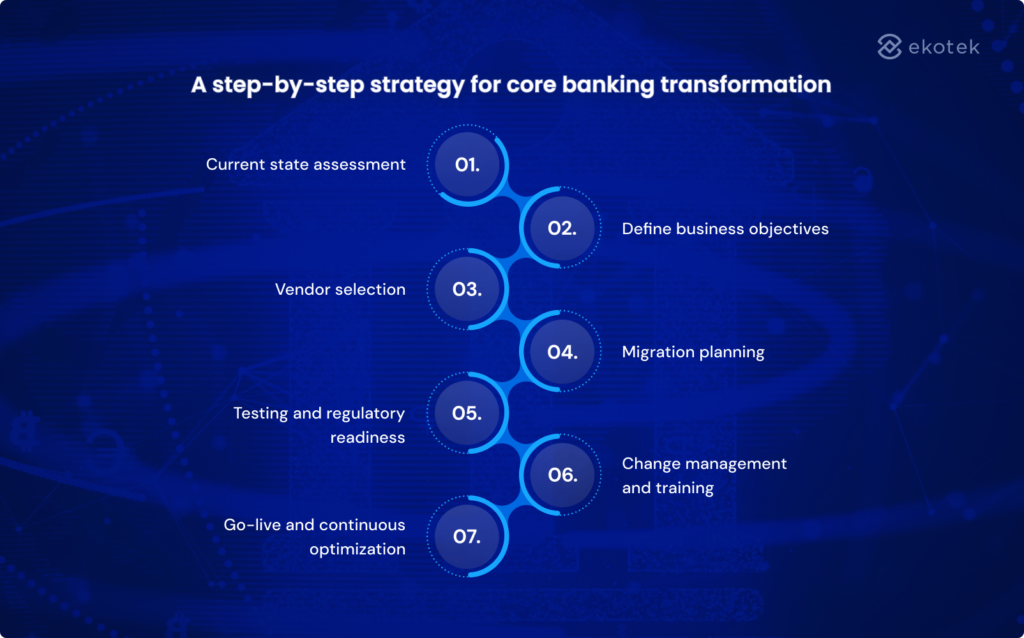
Current state assessment
The transformation journey begins with a deep audit of the existing IT landscape, core platforms, data architecture, integrations, workflows, and operational processes. This diagnostic phase helps uncover technical debt, bottlenecks, and outdated components that limit scalability. A clear baseline allows banks to identify what needs to be replaced, reused, or re-engineered. It also helps set realistic expectations around scope, risk, and timelines.
Define business objectives
Before selecting technology, it’s crucial to align transformation goals with business strategy. These may include faster product delivery, operational cost reduction, improved compliance, better CX, or expanding to new markets. Setting measurable KPIs from the outset ensures accountability and helps prioritize features and investments. Without a clear “north star,” transformation efforts risk being fragmented or misaligned.
Vendor selection
Core banking transformation is highly complex, and most banks lack the in-house expertise to evaluate platforms, manage integration, and ensure compliance at scale. That’s why many institutions choose to outsource the transformation to specialized partners. These providers not only bring technical and regulatory experience, but also help banks select the right core banking platform based on their needs, whether cloud-native, modular, or hybrid, ensuring a better long-term fit and faster implementation.
💡 This guide will walk you through software outsourcing vendor evaluation
Migration planning
There are 2 primary approaches: “big bang” (a full switchover at once) or “progressive modernization” (migrating services in phases). The right choice depends on the bank’s risk tolerance, system complexity, and business priorities. Phased migrations are generally safer and allow for early wins, but they require sophisticated orchestration. Detailed planning must cover data migration, fallback procedures, and rollback scenarios.
💡 See how Ekotek accelerated logistics through legacy migration
Testing and regulatory readiness
Extensive testing, functional, performance, security, and regulatory, is essential before go-live. This includes stress testing under peak loads, validating integration points, and simulating real-world scenarios. Regulatory compliance must be built in, not bolted on. Banks should work closely with legal and risk teams to ensure the system meets both current and anticipated regulatory demands (KYC/AML, data residency, audit trails).
Change management and training
Even the best system will fail without internal adoption. Successful transformation requires engaging employees early, communicating the vision clearly, and providing hands-on training. Change management should also involve customer-facing teams to ensure consistent messaging and support. In some cases, creating internal “champions” or transformation squads can accelerate cultural buy-in.
Go-live and continuous optimization
Go-live is not the finish line, it’s the start of a new operating model. Post-launch, banks should monitor system performance, customer feedback, and operational KPIs in real time. Continuous iteration and optimization are key to realizing long-term ROI. Agile governance models, DevOps practices, and regular retrospectives help maintain momentum and adapt to evolving business needs.
💡 Get the strategy behind modern systems in our Application Modernization Ebook
Key challenges in core banking transformation
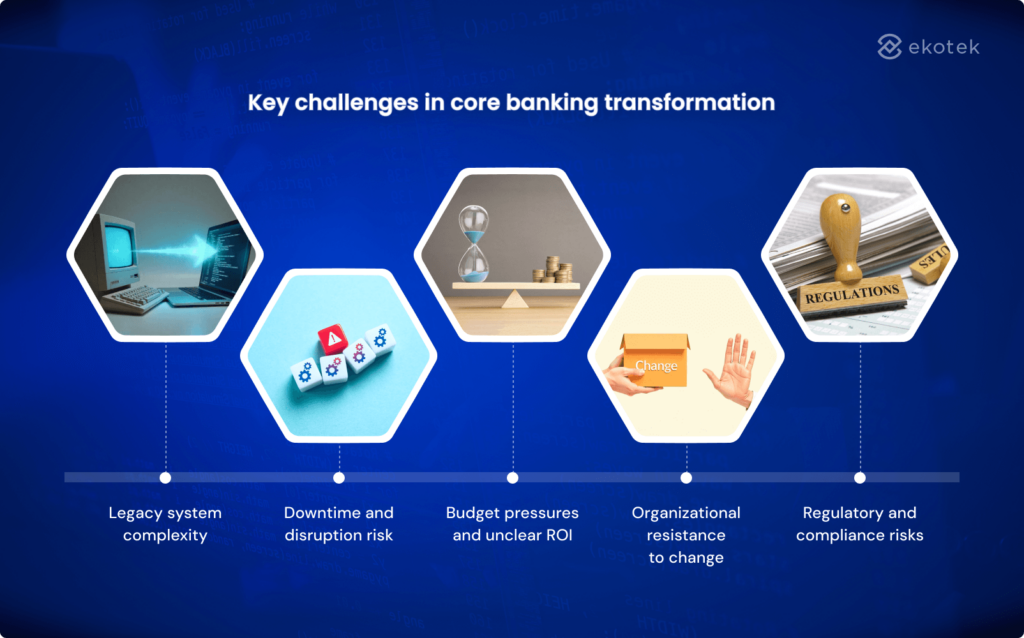
While the benefits of core banking transformation are substantial, the path is rarely smooth. Many institutions underestimate the operational, cultural, and regulatory hurdles involved. Below are the most common and critical challenges banks face during the journey:
Legacy system complexity
Most banks still rely on decades-old systems that were never designed for integration or agility. These legacy platforms often lack proper documentation, are tightly coupled, and require niche expertise to maintain. Untangling this complexity is often one of the most time-consuming and risk-prone aspects of transformation.
Downtime and disruption risk
Core system changes carry significant operational risk. Even short periods of downtime can disrupt customer access, damage trust, and trigger regulatory scrutiny. Ensuring business continuity during migration requires rigorous testing, fallback plans, and experienced implementation teams.
Budget pressures and unclear ROI
Core transformation is expensive, with high upfront costs and benefits that may take years to fully materialize. Without a clear business case and defined success metrics, it’s difficult to secure leadership buy-in or sustain momentum over the long term.
Organizational resistance to change
Technology alone doesn’t drive transformation, people do. Resistance from internal teams, unclear communication, or fear of job displacement can slow progress or lead to project failure. Effective change management, executive sponsorship, and internal education are essential to overcome inertia.
Regulatory and compliance risks
The financial sector operates under intense regulatory scrutiny, and core migration introduces new risks around data integrity, reporting, and operational resilience. A single misstep can lead to compliance violations or reputational damage, so regulatory alignment must be built into every phase of the transformation.
Ekotek case study on core banking transformation
Challenge
The digital division of a major bank was struggling with legacy web systems that underperformed and lacked modern user experience. These outdated platforms created bottlenecks in delivering reliable, high-quality digital services to both internal staff and end customers.
Solution
Ekotek provided a banking-domain-savvy IT team to modernize 2 core systems, one customer-facing and one internal. The team implemented bug fixes, regular maintenance, performance optimizations, and new features built on the latest web technologies and RESTful APIs.
Results
-
- Significantly improved system performance and responsiveness
- Enhanced user experiences for both staff and customers
- High client satisfaction with technical quality and agility in delivery
Future trends in core banking
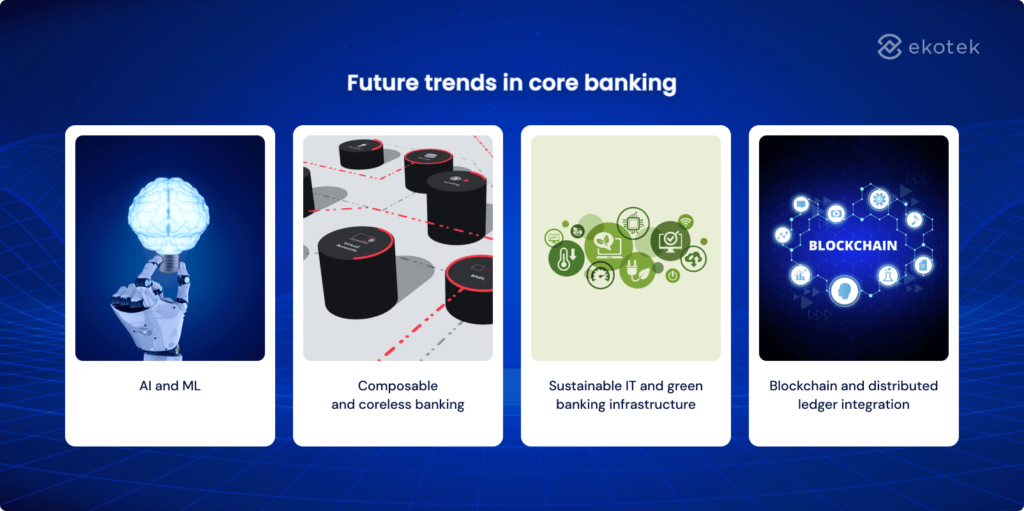
AI and machine learning
AI and ML are playing a growing role in enhancing banking intelligence, especially in areas like fraud detection, credit scoring, and real-time customer engagement. With AI embedded in the core, banks can detect anomalies instantly, make smarter lending decisions, and offer hyper-personalized product recommendations. Modern core systems need to be data-ready and capable of supporting AI models at scale.
💡 Get clarity on AI budgets in our 2025 AI Cost Breakdown
Composable and coreless banking
The traditional one-size-fits-all core system is giving way to composable architectures, where banks can select, assemble, and update interchangeable components. Some are even moving toward a “coreless” model, where core functionality is distributed across microservices connected via APIs. This flexible approach allows for faster innovation, easier upgrades, and better alignment with evolving customer and regulatory needs.
Sustainable IT and green banking infrastructure
As sustainability becomes a strategic priority, banks are looking to reduce the environmental impact of their technology operations. Cloud-based and containerized core platforms can significantly lower energy consumption compared to legacy data centers. Green IT is no longer just good PR, it’s becoming a compliance and investor expectation, especially in ESG-sensitive markets.
Blockchain and distributed ledger integration
Blockchain is beginning to move from pilot projects to production-grade solutions, particularly in cross-border payments, trade finance, and digital identity. Modern core platforms that can integrate with blockchain-based networks will be better positioned to enable real-time settlements, reduce reconciliation costs, and support emerging digital assets.
💡 Explore what’s shaping 2025 in our Digital Transformation Trends
Conclusion
Core banking transformation is a strategic necessity. Legacy systems are holding banks back from delivering real-time, personalized experiences, scaling efficiently, and meeting rising compliance demands. By modernizing their core, financial institutions can accelerate innovation, reduce operational costs, and future-proof their operations.
Ekotek helps financial institutions modernize their core banking systems with precision, speed, and domain expertise. Our teams combine deep knowledge of banking operations with cutting-edge engineering to deliver modular, cloud-ready, and API-first solutions, tailored to each client’s transformation goals. Whether you’re looking to overhaul legacy infrastructure, improve time-to-market, or build scalable digital products, we’ll support you from planning to post-launch optimization.
- 1
- 2
- 3
- 4
- 5
- 6
- 7
- 8
- 9
- 10